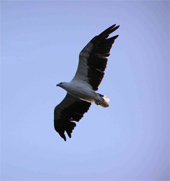



Latest News• Add My News • Search Old News Gippsland › Latest news › Gippsland Portal FeatureIf You See A Sea Eagle, Report It! The White-bellied Sea Eagle is one of Australia’s most majestic and beautiful coastal birds of prey. Unfortunately it is also one of Victoria's most endangered bird species. To improve understanding of numbers and distribution of the Sea Eagle, the Department of Sustainability and Environment (DSE) wants people to report sightings of these birds and their nests. Adult birds are mainly white, have greyish wings and a short, white tipped wedge-shaped tail, with females generally being larger than males. Juveniles, often mistaken for Wedge-Tailed Eagles, are speckled brown with a pale face. They usually acquire their full adult plumage at three years of age. Sea Eagles mate for life, usually producing one or two eggs between April and August. DSE Fauna Officer, Faye Bedford, said most of the information about these birds in Gippsland comes from members of the public: "We are always looking at improving our knowledge of their distribution and numbers, so any information is welcome." Reasons for the Sea Eagles’ declining numbers include loss of habitat caused by the clearing of coastal forests for both agricultural an urban expansion particularly in the central and western coastal areas of "With an impressive wingspan of around two metres, these are big birds and big birds need big trees to nest and roost in. Their nest can be up to two metres across and two metres deep, located in large Eucalyptus trees or cliffs overlooking the ocean, which they build upon year after year," Ms Bedford said. In Gippsland the birds prefer roost sites in prominent living or dead trees, usually nesting in Red Gums or Southern Mahogany. "We often underestimate the value of a tall dead tree and only see it as a good source of firewood. Any dead tree has ecological value and felling it often displaces a wide variety of wildlife species whose life cycle may revolve around it." To ensure privacy for the eagles during nesting, Ms Bedford asks that people observe Sea Eagles from a distance. "They are big birds but surprisingly timid, and they may abandon a nest with eggs and chicks if the disturbance is too great for them. Often people have good intentions by wanting to find the nest, but inadvertently cause the birds to abandon. Watching the birds with binoculars from a distance is highly recommended." To help identification, the Department has a mounted specimen in the front foyer at the new DSE office located on the Source: http://gippsland.com/ Published by: news@gippsland.com Related Articles
|
|